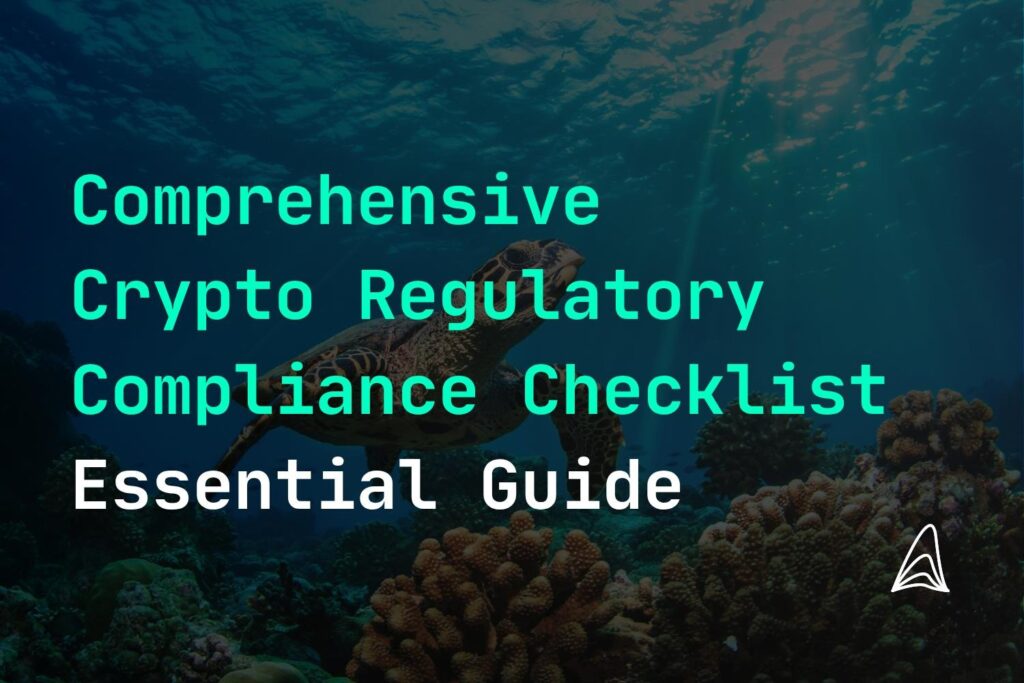
- Jakob Brezigar
- Updated: July 1, 2025
- Reading time: 6 min
Comprehensive Crypto Regulatory Compliance Checklist – Essential Guide

What is “crypto regulatory compliance”?
- Legal compliance – adhering to laws governing securities, commodities, AML/KYC, tax reporting, cybersecurity, and consumer protection.
- Risk and operational compliance – managing liquidity, cybersecurity, business continuity, auditability.
- Regulatory oversight – maintaining transparent reporting and obtaining licenses (e.g., MiCA, FINRA, SEC/CFTC classification).
Why is a compliance checklist critical now?
- U.S. stablecoin legislation – The GENIUS Act (passed June 17, 2025) mandates 1:1 asset backing, audited reserves for large issuers, and AML standards.
- MiCA in the EU – Fully enforceable since December 2024 for crypto‑asset service providers (CASPs), requiring licensing, prudential limits, cyber‑resilience (DORA), and travel‑rule adherence.
- New U.S. bills – FIT21 (passed House May 2024) clarifies roles of SEC vs CFTC.
- Global data standards – OECD’s Crypto‑Asset Reporting Framework (CARF) mandates CASPs report user tax data
What should your crypto compliance checklist include?
1. Legal classification & licensing
- Determine asset status – Are tokens securities (SEC) or commodities (CFTC)? FIT21 defines decentralization tests for this purpose.
- Obtain necessary licenses –
– U.S.: SEC broker‑dealer, MSB license, FINRA crypto‑asset ATS if applicable
– EU: MiCA authorization for CASPs. Phase‑I for stablecoins, phase-II for others
2. AML/KYC and Travel Rule compliance
- Implement tiered KYC, ongoing monitoring, screening against sanctions.
- Meet Travel Rule (FATF, EU Transfer of Funds Reg) for transfers above threshold.
- KPIs: On‑boarding time, screening false positives, SAR filing rate.
3. Reserve backing & financial transparency
- For stablecoins, maintain fully liquid, independent reserves at 1:1 pegging and audited by external firms.
- Internal KPIs: audit completion rate, reserve adequacy ratio.
4. Cybersecurity & operational risk (DORA compliance)
- EU’s DORA (entered Jan 2025) requires cyber resilience, incident management, third‑party ICT due diligence (e.g. hosting providers).
- KPIs: Mean time to detect/respond, external penetration tests, third‑party audit scores.
5. Reporting, auditing & governance
- Routine financial, regulatory, and tax reporting.
- U.S. Section 6045 (2024) impacts transaction-level reporting.
- CARF (OECD): collect user TIN, tax residency, report annually.
- Governance metrics: frequency of board reviews, audit findings resolved.
6. Market integrity & consumer protection
- Monitor for manipulative trading, insider trading, wash trades, flash crashes – key for MiCA, FINRA.
- Disclosures must be fair, balanced, and non‑misleading.
- KPI: Number of flagged transactions, consumer complaints escalated.

How to implement this checklist in practice?
Step-by-step integration process
- Gap analysis – Compare current systems to checklist; document deficiencies.
- Cross‑functional team – AML, legal, treasury, IT, auditors collaborate.
- Select vendor tools – Compliance platforms with automated screening, Travel Rule, reporting dashboards.
- Phased rollout – Pilot in lower risk segments, then scale.
- Training & awareness – Ensure staff understand policies, red flags.
- Internal & external audits – Regularly test policies, refresh frameworks.
Example scenario: A European exchange launching a new token must secure MiCA CASP license, ensure 1:1 reserve for stablecoin tokens, implement travel‑rule tooling, prepare quarterly cyber‑audit reports and align tax reporting under CARF.

What are key KPIs & frameworks to monitor compliance?
- AML/KYC: Monitor the percentage of customer profiles successfully verified, in line with FATF Recommendations and the Travel Rule.
- Reserve Adequacy: Track the reserve ratio (assets vs. liabilities), especially for stablecoin issuers, in compliance with MiCA and related stablecoin regulations.
- Cybersecurity: Evaluate mean time to respond (MTTR), audit scores, and penetration test outcomes, following frameworks like DORA, NIST, and ISO 27001.
- Reporting: Measure the punctuality and accuracy of required filings. This is essential under Section 6045 (U.S.), CARF (OECD), and MiCA (EU).Market Integrity: Keep records of flagged trade anomalies and consumer complaints. These indicators align with FINRA rules and MiCA’s market abuse provisions.
- Governance: Assess how frequently compliance issues are reviewed and resolved, guided by internal audit cycles and governance best practices.
What are the current trends & regulatory developments?
- U.S. federal framework – The GENIUS Act signals a shift to clearer rules for stablecoins.
EU harmonization – MiCA now fully applicable; DORA and DAC8 (upcoming 2026) expanding into cyber, tax reporting. - U.S. overhaul of enforcement – Move from regulatory enforcement to tech‑friendly guidance (SEC, CFTC), evolving market classification (FIT21, Coinbase rulings).
- Global tax transparency – CARF and OECD mandates require CASPs to share client data internationally.
- Cyber & AI compliance tooling – Firms increasingly adopting AI‑based transaction monitoring, wallet analysis, and real‑time risk scoring tools.
How does Orcabay apply this checklist?
- Automated AML screening and Travel‑Rule tools integrated in trading pipelines.
- Real‑time liquidity KPIs (reserve ratios, pegging status) monitored via internal dashboards.
- Continuous cyber‑resilience testing and partner ICT due‑diligence for all cloud services.
- Regular internal audits, supplemented by third‑party reviews for stablecoin reserves and tax reporting.
- Governance routine – Monthly compliance reviews, quarterly board oversight, and annual external attestations.
Conclusion
- Understand asset classification and secure licenses
- Implement robust AML/KYC and Travel‑Rule systems
- Maintain transparent reserves and audited disclosures
- Prioritize cyber resilience and third‑party controls
- Track compliance indicators (KPIs) across areas
- Adopt a structured implementation and audit cycle
Disclaimer: The information provided in this article is for informational purposes only and does not constitute financial, investment, or other professional advice. All opinions expressed herein are solely those of the author and do not represent the views or opinions of any entity with which the author may be associated. Investing in financial markets involves risk, including the potential loss of principal. Readers should perform their own research and consult with a licensed financial advisor before making any investment decisions. Past performance is not indicative of future results.

Jakob Brezigar
Jakob, an experienced specialist in the field of cryptocurrency market making, boasts an extensive international presence. With Orcabay, he has skillfully managed major operations and deals for a wide array of global stakeholders.



